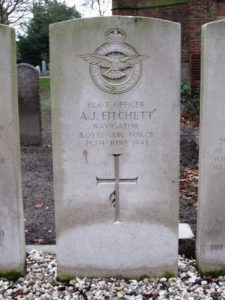Bontddu is a small village located on the northern edge of the Mawddach Estuary in the ancient county of Merionethshire, just over three miles north-east of Barmouth. The village is home to the Clogau Gold Mine, which sparked a mini gold rush in the late 1800’s. The men of the village who fell during both World Wars are commemorated on the village war memorial, which is situated alongside the village hall.
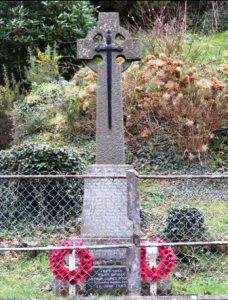
The Great War, 1914-1918
Phillip Brewer, Seaman, Mercantile Marine. Phillip was the son of Frederick and Mary Jane Brewer, of Rhuddalt, Bontddu. He enlisted into the Mercantile Marine as a young man, and by 1918 was serving aboard the brand new cargo steamer SS Ypresville. Phillip had been home on leave early in 1918, recounting tales of a close escape when his previous ship had almost fallen victim to a German submarine, and he joined the crew of Ypresville in July 1918, once it had completed commissioning. Phillip became ill and died of pneumonia during a voyage on 7 December 1918. He was just 18 years old. He is not commemorated as a casualty by the CWGC. Ypresville was later renamed SS Clan MacWhirter, and was sunk by U-156 on 27 August 1942.
John David Davies, Private, 290479, Royal Welsh Fusiliers. John was the son of William and Margaret Davies, of Borth Cottage, Bontddu. He worked as a farm hand prior to enlisting at Dolgellau into the 7th Battalion, Royal Welsh Fusiliers on 28 April 1913. The battalion was a Territorial unit, which mobilised for war at Newtown in August 1914, as part of North Wales Brigade, Welsh Division and moved to Conway until the end of the month, before moving to Northampton. In December the Division moved to Cambridge and then in May 1915 to Bedford, where the Division was numbered and the formation became 158 Brigade, 53rd (Welsh) Division. John appears to have been a bit of a character, judging by his Company Conduct Sheet, which is full of small indiscretions during this period. On 19 July 1915 the entire Division sailed from Devonport for Imbros and on 9 August 1915 landed at Suvla Bay. The infantry moved off the beaches into the bush, but due to a lack of maps and no knowledge of the terrain, many of the units became disorientated, and the situation became chaotic. The Division was eventually evacuated from Gallipoli in December 1915, moving to Egypt to join the EEF, and helped guard the Suez Canal before taking part in operations to drive the Turks out of the Sinai. The EEF then turned its attention onto driving the Turks out of Palestine, and on 26 March 1917 launched its first offensive against the coastal city of Gaza, which guarded the road to Jerusalem. Initial gains during the day were lost when the assaulting divisions lost touch with each other and communication broke down when a thick fog cloaked the battlefield. A second offensive was launched against Gaza on 17 April, but this again failed. John had survived both battles, but was killed during the quieter period of trench warfare which followed, on 25 April 1917, aged 19. He is buried in Gaza War Cemetery, Israel. His brother, Ralph, was killed later that year.
Ralph Davies, Private, 291410, Royal Welsh Fusiliers. Ralph was the son of William and Margaret Davies, of Borth Cottage, Bontddu. He enlisted at Dolgellau into the 7th Battalion, Royal Welsh Fusiliers on 10 December 1915. He was placed on the army reserve until being mobilised on 24 January 1916 and posted to the 3/7th Battalion, Royal Welsh Fusiliers at Park Hall, Oswestry. On 3 July 1916 he was posted to Egypt to join the 1/7th Battalion, Royal Welsh Fusiliers, which had been evacuated there from Gallipoli seven months earlier, and was attached to 158 Brigade, 53rd (Welsh) Division, joining his brother John. He joined the battalion on the Suez Canal on 19 July 1916. The Division was attached to the EEF, and was helping guard the Suez Canal before taking part in operations to drive the Turks out of the Sinai. The EEF then turned its attention onto driving the Turks out of Palestine, and on 26 March 1917 launched its first offensive against the coastal city of Gaza, which guarded the road to Jerusalem. Initial gains during the day were lost when the assaulting divisions lost touch with each other and communication broke down when a thick fog cloaked the battlefield. A second offensive was launched against Gaza on 17 April, but this again failed. The situation bogged down into routine trench warfare for several months, while the commander of the EEF was replaced by Sir Edmund Allenby, who formulated a new plan for another assault, known as the Thirds Battle of Gaza. The Allies were to attack the Turkish lines on a broad front ranging from Gaza to Beersheba, and the planned date for the offensive was to be 1 November 1917. The 53rd Division had moved into position during the days leading up to the attack, and on 27 October 1917, 158 Brigade carried out an operation known as the ‘Backsheesh Stunt’ and suffered heavy casualties taking two hills. Ralph was killed in action during the days fighting. The 23-year-old has no known grave and is commemorated on the Jerusalem Memorial, Israel. His brother, John, had been killed in April.
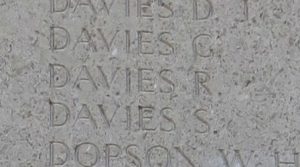
Horace James Heasman, Rifleman, 2809, London Regiment. Horace was born in Bontddu in 1893, the son of Edgar and Alice Heasman. His father was a gardener and by 1901 had moved the family to 8, Palmerston Road, West Croydon. Horace enlisted in London into the 6th Battalion, London Regiment (City of London Rifles). The battalion was attached to the 4th London Brigade, 2nd London Division at Watford and on 18 March 1915 landed at Havre. On 11 May 1915 the formation became 140 Brigade, 47th (London) Division. It saw its first major action at the Battle of Aubers Ridge, and at the subsequent Battle of Festubert during May 1915. During early September Horace’s battalion was at Houchin, carrying out training in preparation for the forthcoming Battle of Loos. On 24 September the battalion was at Nouex-les-Mines, and received its orders for the forthcoming attack the following day. By 05.30 on 25 September 1915 Horace’s battalion was in position ready for the attack, and at 05.50 advanced behind a gas screen towards the Double Crassiers. The men were met by heavy machine-gun fire, and terrible casualties were suffered. Horace was killed at some time during the day. He was 21 years old and is buried in Maroc British Cemetery, Grenay, France. Horace is not commemorated on the Bontddu Memorial.
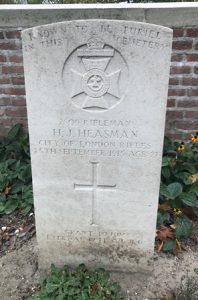
Griffith Jones, Gunner, 279732, Royal Field Artillery. Griffith was the son of William and Ellen Jones, of Brynafon, Bontddu. Griffith had served during the war with A Battery, 117th Brigade, Royal Field Artillery. He survived the war, returning home to Brynafon, but died on 13 July 1920, aged 21. He was buried in Llanelltyd Cemetery on 15 July 1920. Griffith is not commemorated on the Bontddu Memorial.
John Jones, Private, 23413, Royal Welsh Fusiliers. John was born at Llansawel, the son of Evan and Ellen Jones. His parents later moved to Tynglanyrafon, Bontddu. John resided in Whitland and then at Cwmtwrch prior to the war, finding work as a coalminer. He enlisted at Carmarthen into the army and was posted to the 10th Battalion, Royal Welsh Fusiliers. The battalion was attached to 76 Brigade, 25th Division at Codford St. Mary, Salisbury Plain, where the men received their basic training, before moving to Romsey then Aldershot. On 27 September 1915 John landed in France with the battalion, and the Division assembled in the southern sector of the Ypres Salient. Two weeks later 76 Brigade transferred to the 3rd Division. The 10th Royal Welsh Fusiliers saw their first major action with the Division during the actions of the St. Eloi craters, south of Ypres, during March 1916. The action began when the British exploded six underground mines on 27 March, and rushed forward, capturing four of them, thus extending their front line. John was badly wounded by gunshot wounds to his buttocks during the ensuing fighting, and was brought to the No. 13 General Hospital at Boulogne on 1 April 1916. He died there of his wounds on 4 April 1916, aged 29, and is buried in Boulogne Eastern Cemetery, France.
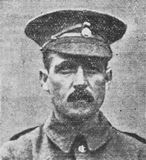
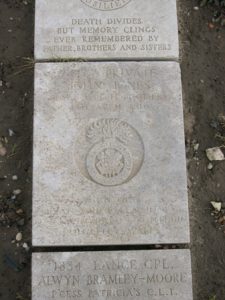
Edward Enfield Lawford, Lieutenant, Indian Army. Edward was born at Notting Hill on 10 July 1882, the son of Percy Lawford and Anne Lawford (née Aikin). By 1911 his parents had taken up residence at Borthwnog, Bontddu. He was educated at Bedales School and then studied mine engineering at Cambourne College. On 14 April 1905 Edward embarked at London aboard the SS Manora for Madras, and spent five years working at the Ooregum Gold Mine. He returned home in 1910 to visit his parents at Borthwnog, but in 1911 left for Ceylon. Edward was commissioned into the Indian Army in December 1914, and was posted to the 20th Deccans Horse. The battalion sailed for Europe in June 1915 attached to the Secunderabad Cavalry Brigade, 2nd Indian Cavalry Division. On 1 January 1917 the Secunderabad Cavalry Brigade became attached to the 5th Cavalry Division. On 13 June 1917 Edward’s battalion launched an assault on Ascension Wood, and encountered heavy resistance. Edward was last seen entering the wood, and was later judged to have been killed in action during the days fighting. The 34-year-old has no known grave and is commemorated on the Neuve-Chapelle Memorial, France. He is also commemorated on the Dolgellau memorial.
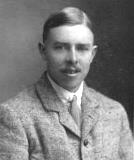
Hugh Pugh, Lance Corporal, 63456, Machine Gun Corps. Hugh was the son of Hugh and Jane Pugh, of Glanronwy, Bontddu. He enlisted at Dolgellau into the 7th Battalion, Royal Welsh Fusiliers, but after completing his training was posted to the 17th Battalion, Machine Gun Corps, which was attached to the 17th (Northern) Division. The Division took part in several terrible engagements in 1918 after Hugh arrived in France. In March 1918 the Division was on the Somme, and faced the German Spring Offensive, seeing heavy fighting during its withdrawal westwards. It was moved out of the line to rest before being moved to the southern sector of the Somme and took part in the Battle of Amiens on 8 August 1918. The battle proved to be the breaking point for the Germans, and from now on the Allies went on the offensive. The Division took part in the great advance towards the Hindenburg Line over the coming weeks, taking part in the Battle of Havrincourt on 12 September and the Battle of Épehy on 18 September. Hugh was killed in action near Épehy on 20 September 1918, aged 34. He has no known grave and is commemorated on the Vis-en-Artois Memorial, Haucourt, France.
John Pugh, Private, G/12947, East Surrey Regiment. John was the son of John and Mary Ann Pugh, of 1, Cefn Cam Cottage, Bontddu. He enlisted into the East Surrey Regiment at Rotherhithe under the name of Charles Williams soon after the outbreak of war. He was posted to the 12th Battalion, East Surrey Regiment, which was attached to 122 Brigade, 41st Division. On 2 May 1916 John landed in France with the battalion, which moved with the Division to Steenweerck, south of the Ypres Salient, for trench initiation in Ploegsteert Wood. During the following weeks the 12th East Surreys took its turn in the normal system of trench rotation and by the end of June was ready to launch its first offensive with the Division. On the morning of 30 June 1916 the Divisional Artillery launched a barrage against the German lines opposite, then released a cloud of gas before a large-scale raiding party left the trenches and crossed No Man’s Land into the German front line. John was among 14 men killed during the attack that day. He was 26 years old and is buried in London Rifle Brigade Cemetery, Belgium.
Evan Thomas, Private, 61036, Royal Welsh Fusiliers. Evan was born at Crugan Bychain, Bontddu in 1893, the son of Owen and Elizabeth Thomas. The family later resided at 4, Graigydon Cottage, Barmouth. He was called up for military service early in 1917, and took the case to the Military Appeal Tribunal for exemption but was refused, so enlisted at Dolgellau into the 3rd Battalion, Royal Welsh Fusiliers. Evan was posted to Ireland with the battalion on Garrison duties. He fell ill in Ireland and died of disease in hospital in Limerick on 18 January 1918, aged 25. His body was returned home and he was buried in St. Enddwyn’s Churchyard, Llanenddwyn. Evan is not commemorated on the Bontddu memorial, but at Barmouth.
Evan Williams, Private, 291133, Royal Welsh Fusiliers. Evan was born at Trawsfynydd in 1893, the son of Evan and Sarah Williams. He was working at Ffridd Farm, near Bontddu by 1911 and piror to the war was living at Bwlch Coch, Bontddu. Evan enlisted at Blaenau Ffestiniog into the 7th Battalion, Royal Welsh Fusiliers on 15 August 1915 and was posted to the 3/7th Battalion, Royal Welsh Fusiliers at Park Hall, Oswestry. On 3 July 1916 he was posted out to Egypt, joining the 1/7th Battalion, Royal Welsh Fusiliers, which was attached to 158 Brigade, 53rd (Welsh) Division. The Division had seen service at Gallipoli the previous year and upon being evacuated to Egypt in December 1915 joined the EEF, on the Suez Canal defences. During 1916 the Division took part in operations to drive the Turks out of the Sinai. The EEF then turned its attention onto driving the Turks out of Palestine, and on 26 March 1917 launched its first offensive against the coastal city of Gaza, which guarded the road to Jerusalem. Initial gains during the day were lost when the assaulting divisions lost touch with each other and communication broke down when a thick fog cloaked the battlefield. A second offensive against Gaza was launched on 17 April, but again failed, so command of the EEF was given to Sir Edmund Allenby who reorganised his forces before launching an assault against a broader front, from Gaza to Beersheba, on 6 November 1917, an offensive which is known as the Third Battle of Gaza. Evan was killed in action during the opening day of the battle, on 6 November 1917, aged 24. He has no known grave and is commemorated on the Jerusalem Memorial, Israel.
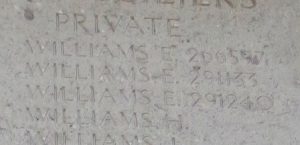
World War Two, 1939-1945
Arthur James Fitchett, Pilot Officer, 138391, Royal Air Force Volunteer Reserve. Arthur was born on 11 June 1910, the son of Thomas Fitchett and Elizabeth Grace Fitchett (nee Williams), of Caerdeon Bungalow, Bontddu. He was a schoolmaster at West Bromwich prior to the war. Arthur enlisted into the Royal Air Force Volunteer Reserve, and trained as a Navigator before being posted to 51 Squadron, RAF on 20 April 1943. The squadron was equipped with Armstrong Whitworth Whitley’s at the outbreak of war, before re-equipping with the Handley Page Halifax, and flew as part of No. 4 Group RAF, operating from RAF Snaith. On the morning of 25 June 1943, Arthur took off from Snaith aboard Halifax II, Serial JD250, as part of a large force despatched to bomb Wuppertal, Germany. The Halifax was intercepted by a German night fighter when about 20km off Holland, and was shot down into the sea, killing all its crew of seven. Arthur’s body was recovered from the sea at some time afterwards, and he was buried in Castricum Protestant Churchyard, Netherlands. Only one other body, that of Air Gunner Murdoch, was recovered from the crash.
